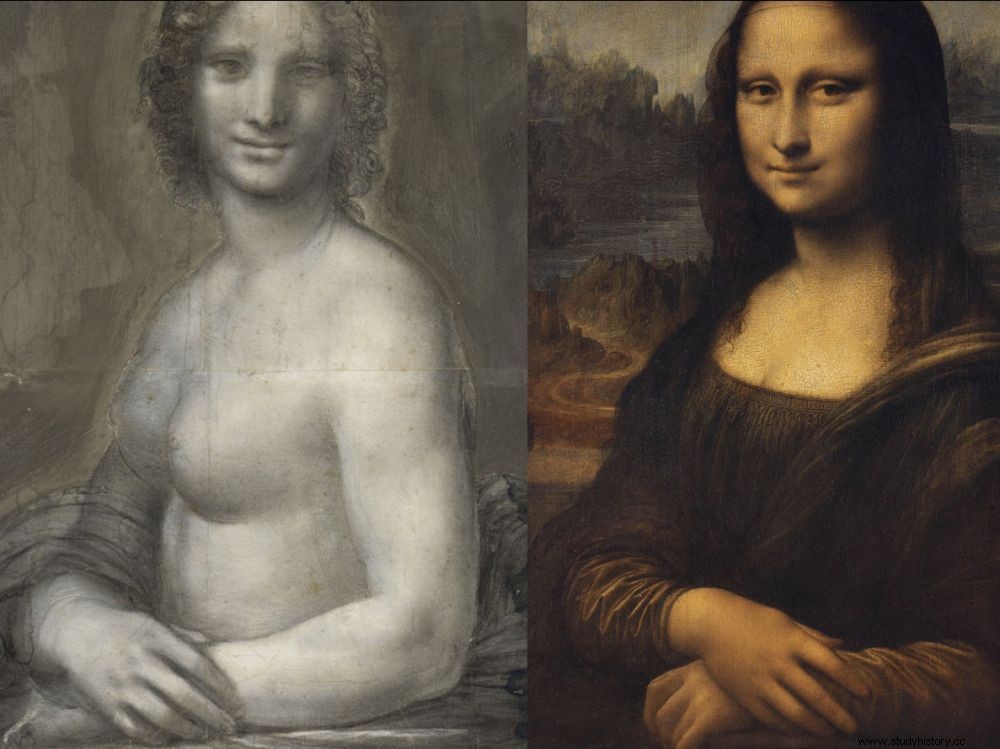Back to "The Naked Mona Lisa", an enigmatic work presented as a double of Mona Lisa... But what is it really?

The drawing of "The Naked Mona Lisa", and that of "The Mona Lisa".
The posture, the hands, details of the smile... For several days, these elements appearing on a charcoal drawing of the XV th /XVI e century belonging to the collections of the Condé de Chantilly museum (Oise) have caused the wildest rumors. It could be - nothing less - than a naked Mona Lisa, the famous Mona Lisa, moreover, probably by the very hand of Leonardo da Vinci, the famous painter of the 15th th -XVI e century! Is it so safe?
"Analysis of this drawing titled 'Naked Mona Lisa' is well underway , recognizes Nicole Garnier, chief curator of the Condé de Chantilly museum (Oise), these examinations being carried out in Paris under the direction of chief curator Bruno Mottin. However, there is no evidence that this cartoon is by Leonardo himself! ". It is in the laboratories of the Center for Research and Restoration of the Museums of France (C2RMF), located under one of the wings of the Louvre, that La Joconde Naked was subjected for several weeks to a battery of examinations (infrared reflectography, X-ray microfluorescence, ultraviolet rays). "These helped highlight certain components of the design and bring out elements that are no longer visible to the naked eye “says Mathieu Deldicque, assistant curator at the Condé de Chantilly museum.
Why so much sudden interest in a well-known work, which is moreover already analyzed in 1995? “Because at the time we did not have these first investigations of the technologies available today, and we are preparing a major exhibition for 2019! », continues Mathieu Deldicque. Preserved at the Condé museum – which houses the second largest collection of paintings in France – the delicate drawing had been purchased by the Duke of Aumale in 1862. At the head of a great fortune, this son of King Louis-Philippe, then exiled in England, had acquired it for the amount of 7000 francs, an enormous sum at the time. "The Duke of Aumale was convinced that it was a drawing by the hand of Leonardo da Vinci “, explains Nicole Garnier.
With the exception of breasts, few features are feminine
The analyzes underway in Paris have, however, just delivered crucial information. They establish in particular that the drawing was abundantly taken up and worked on at different times. "This bust of a naked woman with her hands placed in the foreground, in a composition identical to that of the Mona Lisa, is made up of several sheets of paper glued together, with a central figure made in charcoal", describes Nicole Garnier. With the exception of the breasts, few features are feminine, especially the musculature and the shoulders. “It was very common at the time for a young man from the studio to be posed, which Leonardo often did with his own apprentices , continues the expert. It has also been proposed that 'La Joconde Nue' was the work of a collaborator of Leonardo da Vinci based on one of the master's lost compositions .
“This drawing could have been a preparatory model for an oil painting”
You should know that there are indeed about fifteen other works close to this drawing, some in particular at the Hermitage Museum in Saint-Petersburg (Russia), which are not by Leonardo's hand. “This drawing could have been a preparatory model for an oil painting “, adds Nicole Garnier. This seems to be confirmed by the presence of pinholes identified by the analyzes around the work, indicating that it was transferred to a panel. Analysis of the watermarks of the Italian paper has also made it clear that the work was executed between 1485 and 1538. Leonardo da Vinci having died in 1519, "we believe that this drawing was made at least in the Leonardo's workshop or by someone close to him, such as one of his students “, believes Mathieu Deldicque. Did Leonardo intervene himself, drawing a few lines with his hand? The analyzes do not allow for the moment to affirm it. Traces of the intervention of a possible left-hander, which was Leonardo, are thus sought.. A quest for the moment unsuccessful.
